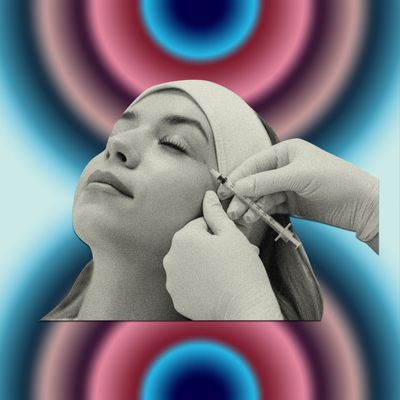
You may have heard there’s a new neuromodulator in town. Or maybe not, because for a lot of people, any injectable that freezes expression lines is “Botox,” in the same way “Kleenex” is a blanket name for any brand of tissues. There are, in fact, six different FDA-approved neurotoxins: Botox, Xeomin, Dysport, Jeuveau, Daxxify, and now, Letybo — an import from Korea that started arriving in dermatologists’ offices in the United States in March. They all share the active ingredient, botulinum toxin type A, which relaxes wrinkles by interrupting signals between nerves and muscles. So why would a dermatologist want to add Letybo to the arsenal, given what’s already available? Should you give it a (literal) shot?
How long has Letybo been used outside of the U.S.?
Letybo is the No. 1 neuromodulator in Korea, where it has been available under the name Botulax since 2016. It’s sold in 65 countries total. According to its manufacturer, Hugel, more than 31 million vials have been administered worldwide. Like all of its botulinum toxin type A cohorts, it has an excellent safety profile.
This track record is what attracted many early adopters of the injector in the United States. “I started using it because a group of trusted South Korean colleagues of mine have been using it for an extensive period of time, and I am a huge fan of the Korean approach to aesthetics,” says Jennifer Levine, M.D., a dermatologist and double-board-certified plastic surgeon who introduced Letybo to her New York practice in March.
Letybo is frequently mixed with hyaluronic acid and injected superficially as a “skin booster” to smooth skin texture and pore size. In South Korea, “Practitioners also use neurotoxin for the body in ways that aren’t as popular here — like to change the shape of calves, traps, and deltoids.” In the U.S., Letybo is currently FDA-approved only for use in the glabellar lines (the “11’s”) between the brows, but dermatologists are also applying it “off label” to areas like crow’s-feet and platysmal bands in the neck.
Would I notice a difference if I had Letybo injected instead of another neuromodulator?
You might — at first. “It may take effect faster than Botox in a high percentage of patients, with an onset of about three days versus potentially up to seven,” says Los Angeles–based dermatologist Ava Shamban, M.D., who was a clinical investigator in the trials that led to Letybo’s FDA approval.
Triple-board-certified cosmetic surgeon Sheila Barbarino, M.D., who has been injecting Letybo since it first became available, reports that some people see a difference as soon as a day after injection. After that, you can expect the performance to be about the same, with a muscle-relaxing duration of about four months.
Are there any other differences between Letybo and traditional Botox?
Botox has been around for 25 years, so while the toxin is the same, Letybo’s manufacturers claim to have newer, more high-tech production protocols. “Letybo is produced through enzyme-free manufacturing, using double chromatography, which contributes to purity of the toxin by removing bacterial side products and nucleic acids,” Dr. Shamban says.
Though the specifics of how Letybo is made won’t really affect consumer experience, it does contribute to ease of use for injectors. “Unlike Botox and most of the other neurotoxins, you don’t have to refrigerate it,” says Dr. Barbarino, “which makes for easy storage.”
Is Letybo more affordable than Botox?
It can be, depending on the provider. Typically, 25 units of neurotoxin are needed to treat the area between the brows: Botox costs $12 to $18 per unit, while Letybo is more likely to cost $9 to $12. Because of the way that Hugel batches and distributes Letybo, it can be less expensive for dermatologists and surgeons to stock. Most neuromodulator manufacturers offer discounts to injectors if they purchase in bulk or if they also purchase other products, including fillers or even laser devices, from their portfolio. This makes sense for large multi-doctor offices and med spas that do hundreds of injections every day, but it can be hard for smaller practices to compete. “With some companies, you can’t buy their neuromodulators unless you buy 250 vials,” says Dr. Barbarino. “With Letybo, whether you buy one vial or 50 is up to you. That makes it much less expensive for me, and I can pass that along to my patients. It’s perfect for those who just want a little bit of neuromodulator but don’t want to spend a ton of money.”
So who is Letybo best for?
Anyone. Providers will simply be adding it to the mix of neuromodulators they already offer. “Most patients want the best result, so the injector and the technique or pattern of placement is the most important part, rather than the product itself,” says Dr. Levine, who notes that patients rarely ask for any neuromodulator by name (again, “Botox” has it covered).
That said, Letybo may turn out to have a cachet among K-beauty fans, who perceive any South Korean skin-care–related product to be innovative and fun to try. “It may have added appeal for some segments of both millennials and Gen X who respond to K-culture,” says Dr. Shamban. Follow a ten-step regimen? This will get the job done a lot faster.
Send your questions to AskABeautyEditor@nymag.com. (By emailing, you agree to the terms here.)
More Beauty Advice
- Is There Halloween Makeup That Won’t Break Me Out?
- Zoomers Are Obsessed With Rhode. Will It Work For Me?

